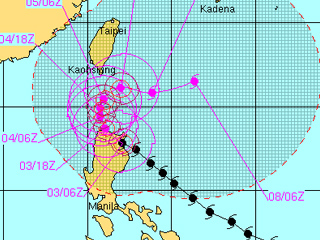 According to Aileen Torres, administrator of the Philippine National Red Cross in Cagayan, that 140 volunteers have sought shelter after reporting that several areas were "very hard to penetrate."
According to Aileen Torres, administrator of the Philippine National Red Cross in Cagayan, that 140 volunteers have sought shelter after reporting that several areas were "very hard to penetrate." "Everything was in chaos. Branches all over area scattered in several places. Power supply was cut off," Torres told ANC as she described the situation in the province.
Chito Castro, head of the Office of Civil Defense in Cagayan Valley, said the typhoon was blowing "very, very strong winds" over the province.
Castro said several trees were being uprooted while ABS-CBN correspondent Jorge Cariño reported that several roofs have been torn off houses. Communication lines have also been cut off, reports added.
Torres said water have overwhelmed two bridges in Tuao town and Tuguegarao City and have been rendered impassable.
She said they were able to evacuate at least 50 families from four villages in Tuao and Sta. Ana towns before Pepeng made landfall in the province.
Based on the satellite image released by weather bureau Philippine Atmospheric, Geophysical and Astronomical Services Administration (PAGASA) at 3 p.m., Pepeng's circulation was already covering Cagayan Valley.
Other Cagayan Valley provinces, including Isabela, Batanes, Quirino, and Nueva Vizcaya have also been experiencing Pepeng's wrath.
The weather bureau had earlier expected Pepeng to make landfall early Saturday evening over Cagayan, but its speed suddenly accelerated around 1:00 p.m.
Nathaniel Cruz, PAGASA' spokesman, said they expect Pepeng to make landfall at 3 p.m., four hours ahead of the weather bureau's earlier prediction.
The weather bureau said in its 1:30 p.m. report that the typhoon significantly accelerated from 17 kilometers per hour to 24 kph. It moved west northwest with maximum sustained winds of 175 kph and gusts of up to 210 kph.
The typhoon was expected to cross northern Luzon overnight and move 260 kilometers west of Basco Batanes or 270 kilometers northwest of Laoag City by Sunday morning.
PAGASA hoisted Signal No. 3 over Cagayan, Batanes Group of Island, Babuyan and Calayan islands, Ilocos Norte, Ilocos Sur, Mountain Province, Abra, Apayao, Kalinga and northern part of Isalea.
Signal No. 2 was raised over the rest of Isabela, Ifugao, Nueva Vizcaya, Benguet and La Union while the provinces of Quirino, Aurora, Nueva Ecija and Pangasinan were under Signal No. 1.
Rains over Metro Manila
Cruz said the concentration of rainfall from Pepeng will pour over the western side of northern and central Luzon, including Metro Manila.
He said more rains were expected to fall starting 8 p.m. Saturday and the downpour will continue until Monday night.
Cruz reiterated that the amount of rainfall of Pepeng will be lesser compared to that of dumped by tropical storm Ondoy (international codename Ketsana), which flooded a large part of Metro Manila on Saturday.
Susan Espinueva, head of PAGASA's hydrometeorological services, said only areas in Rizal, Laguna and Marikina are in danger of experiencing higher levels of floodwaters because of the spilling Laguna de Bay.
Espinueva, meanwhile, reported that they are not expecting floods in Isabela and Aurora provinces because the water level in Pantabangan Dam, which throws water to Cagayan River, has already normalized.
She said the release of waters from Angat, Ambuclao and Magat dams continued as of 10 a.m., but calmed fears of flashfloods in surrounding areas.
Preemptive evacuation
President Gloria Macapagal Arroyo on Friday placed the country under a state of calamity as she ordered preemptive evacuations in areas expected to be hit by the typhoon.
The National Disaster Coordinating Council (NDCC) reported Saturday morning that thousdands of people living in critical areas in La Union, Cagayan, Isabela, Batanes, Quirino provinces have been evacuated.
More than 20,000 families or more than 100,000 people have also been evacuated in Bicol and a few hundred more were brought to evacuation centers in the Calabarzon area.
The government has also announced the allotment of a P100 million calamity fund for the continuing relief efforts for the victims of tropical storm Ondoy, which entered the country last week and left nearly 300 people dead and 42 more missing.
PAGASA head Frisco Nilo said coastal areas on the eastern seaboard of northern Luzon, including Cagayan, Isabela, Aurora, Quezon and Catanduanes should still watch out for storm surge, which may be triggered by Pepeng’s strong winds.
Related Post:



No comments:
Post a Comment